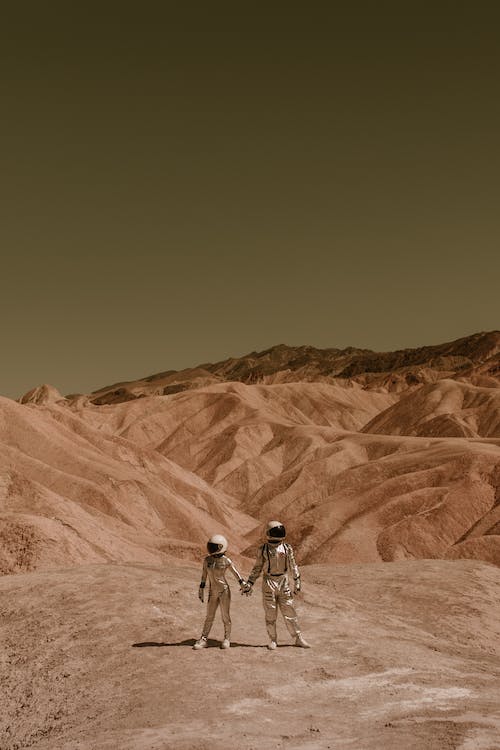As we all know, Earth, the only planet where life exists and thrive. People enjoy summer with countless pristine beaches, spend the winter holiday on some of the most excellent ski resorts in the world scattered on the different continents, or hike some mountains to witness outstanding vistas. Earth is truly a home to all living organisms. But do you know that Mars is also a potential planet for life to survive? Yes, but with time we cannot tell when. Mars was discovered to have water in it. NASAconfirmed in 2015 that liquid water flows intermittently on present-day Mars. In the same year, NASA’s scientists gathered and used data from their Cassini mission to find out that a global ocean lies beneath Saturn’s moon Enceladus’s icy crust. Scientists believe that Jupiter’s moon Europa has a subsurface ocean as well.
Not only that Mars have water, but it is also home to volcanoes and mountains! Here, here some of the tallest mountains on Mars.
Olympus Mons
Located in the Tharsis Montes region near the Martian equator, Olympus Mons is Mar’s highest mountain and volcano. It towers 16 miles (25 kilometers) above the surrounding plains, about three times higherthan Mt. Everest, and stretches across 374 miles (624 km) — roughly the size of the state of Arizona. Due to the lava eruption, the volcano makes the tallest and widest mountain on Mars, being 550 kilometers wide, covering an area larger than the entire Hawaiian Islands chain. The mountain is very flat, which slopes by only 2 to 5 degrees.
Ascraeus Mons
This is an extinct large shield volcano in the Tharsis region of the planet Mars. It is the northernmost and tallest of three shield volcanoes collectively known as the Tharsis Montes and at the Tharsisquadrangle 11.8°N, 255.5°E (104.5W). Originally,it’s called AscraeusLacus, which is from Ascra, the rustic birthplace of Hesiod. Greek Ascraeus means a poetic metonym for “Rural.” It has its official name as Ascraeus Mons in 1973.
Arsia Mons
Of the three mountain volcanoes Tharsis Montes, Arsia Mons is in the southernmost, on the Tharsis bulge near the equator of the planet Mars. It is at 8.35 S and 120.09 W (239.91 E) in the PhoenicisLacus quadrangle. Pavonis Mons is on its north, and Olympus Mons is to its northwest.
The name came from a corresponding albedo feature on Giovanni Schiaparelli’s map, which he named after the legendary Roman forest of Arsia Silva. Researchers gathered pieces of evidence that the mountain volcano has glaciers. There were also seven cave entrances discovered on the sides of Arsia Mons. Researchers see this as a possible reservoir of water ice or even life as possible for settlement. With Mar’s low gravity, lava tubes may be over 800 feet wide. This lava tube could protect colonists from meteorites and radiation. The lack of a magnetic field at present makes Mars have a fair amount of radiation, especially from cosmic ray sources. A National Geographic in 2016 mini-series depicted how people could establish a base in a cave.
Pavonis Mons
Rising 12km above its surrounding plains, PavonisMons is the central volcano of the three volcanoes that comprise Tharsis Montesand straddle the Martian equator between longitudes 235°E and 259°E. Thesegently sloping shield volcanoes look like flattened domes and are built almostexclusively of lava flows.Mariner 9 spacecraft in 1971 discovered the volcano,which was initially called Middle Spot due to its location. It received itsofficial name in 1973, as Pavonis Mons. Its peak equatorial location and itsheight make it the ideal terminus for a space elevator. It has often beenproposed as a space elevator spot, especially in science fiction.The mountain volcano stands at Tharsis quadrangle’ssouthern edge – about 400 km southwest of Ascraeus Mons and 400 km northeast ofArsia Mons.
Elysium Mons
This mountain volcano is in Elysium volcanic province, at 25.02°N 147.21°E, in the Martian eastern hemisphere. It elevates 12.6 km above its base and about 14.1 km (46,000 ft) above the Martian datum. It is the third tallest Martian mountain in terms of relief and the fourth highest in elevation. Its diameter is approximately 240 km, with a summit caldera about 14 km across.

